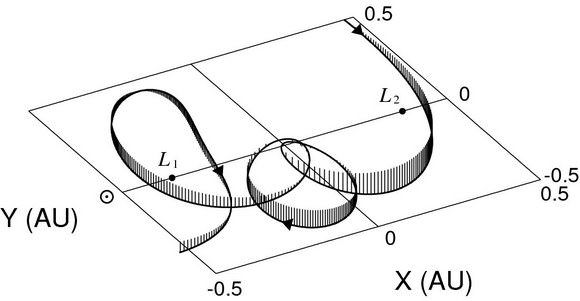[/caption]
Jupiter’s gravity well has been known to capture objects – evidenced by the recent impact on the gas giant discovered by amateur astronomer Anthony Wesley. But one object captured by Jupiter in the mid 1900’s was later able to escape from the planet’s clutches. Researchers have found comet 147P/Kushida-Muramatsu was captured as a temporary moon of Jupiter, and remained trapped in an irregular orbit for about twelve years. “Our results demonstrate some of the routes taken by cometary bodies through interplanetary space that can allow them either to enter or to escape situations where they are in orbit around the planet Jupiter,” said team member Dr. David Archer.
With this discovery, five such objects have now been discovered where the phenomenon of temporary satellite capture (TSC) has occurred, but this new research suggests it might happen more frequently than was expected. Kushida-Muramatsu orbited Jupiter between 1949 and 1961, the third longest capture period of the five objects.
An international team led by Dr. Katsuhito Ohtsuka modeled the trajectories of 18 “quasi-Hilda comets,” objects with the potential to go through a temporary satellite capture by Jupiter that results in them either leaving or joining the “Hilda” group of objects in the asteroid belt. Most of the cases of temporary capture were flybys, where the comets did not complete a full orbit. However, the research team used recent observations tracking Kushida-Muramatsu over nine years to calculate hundreds of possible orbital paths for the comet over the previous century. In all scenarios, Kushida-Muramatsu completed two full revolutions of Jupiter.

“Asteroids and comets can sometimes be distorted or fragmented by tidal effects induced by the gravitational field of a capturing planet, or may even impact with the planet,” said Archer, as did comet D/1993 F2 (Shoemaker-Levy 9), which was torn apart on passing close to Jupiter and whose fragments then collided with that planet in 1994. Previous computational studies have shown that Shoemaker-Levy 9 may well have been a quasi-Hilda comet before its capture by Jupiter. The object that impacted with Jupiter this July, causing a new dark spot may also have been a member of this class, even if it did not suffer tidal disruption like Shoemaker-Levy.
“Our work has become very topical again with the discovery this July of an expanding debris plume, created by the dust from the colliding object, which is the evident signature of an impact. The results of our study suggest that impacts on Jupiter and temporary satellite capture events may happen more frequently than we previously expected,” said Asher.
The team has also confirmed a future moon of Jupiter. Comet 111P/Helin-Roman-Crockett, which has already orbited Jupiter three times between 1967 and 1985, is due to complete six laps of the giant planet between 2068 and 2086.
“Fortunately for us Jupiter, as the most massive planet with the greatest gravity, sucks objects towards it more readily than other planets and we expect to observe large impacts there more often than on Earth. Comet Kushida-Muramatsu has escaped from the giant planet and will avoid the fate of Shoemaker-Levy 9 for the foreseeable future,” said Asher.
The discovery was be presented at the European Planetary Science Congress in Potsdam.
Source: Europlanet


Ah, yes, that makes sense to me, considering the work on “interplanetary freeways” and low energy transfers I just recently became aware of.
So it’s really a gravitational dance out there.
Wonder if this type of capture process extend to stars during galaxy collisions – I don’t see why not? It must be like having a lot of extra club visitors that show up on their way elsewhere.
[Btw, how do one handle this? Try to get statistical measures of capture periods and of the objects involved? If it’s as chaotic as it looks, I’ll bet it is a power-law on periods involved, with a few a priori amazingly long capture periods. If so, wow!]